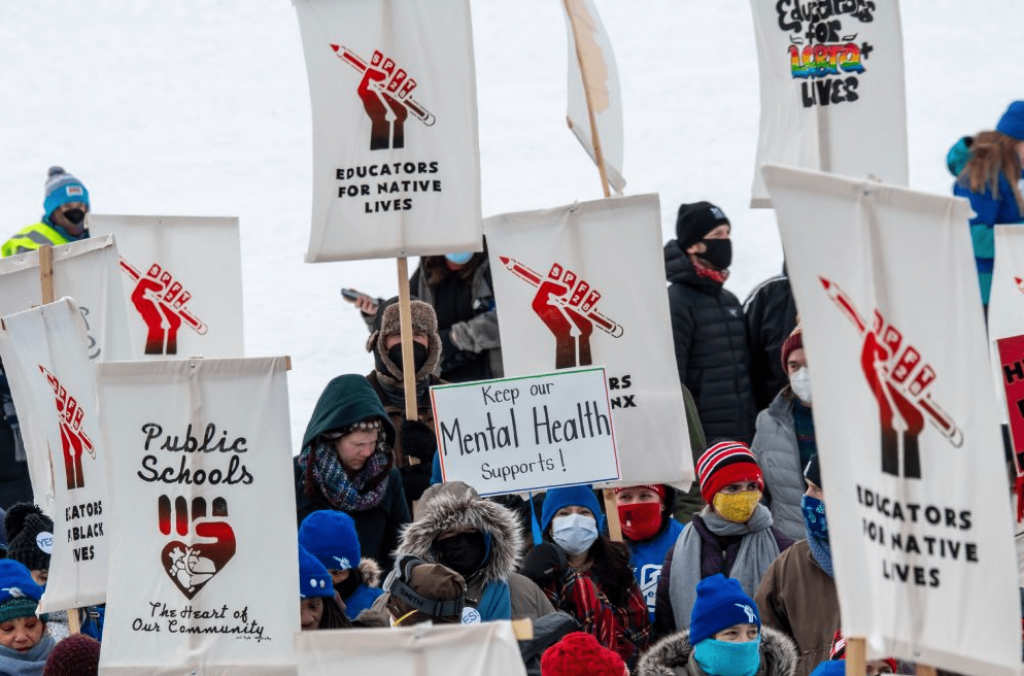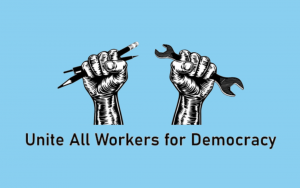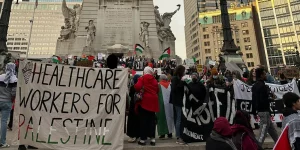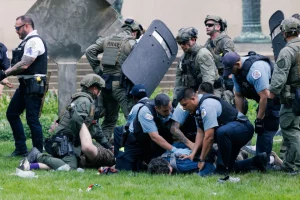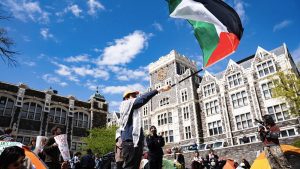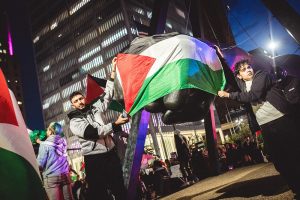Update: St. Paul teachers settled at tentative contract on Monday night. They did not go on strike. Minneapolis teachers are currently on strike. (3/8/22)
Nothing captures the spirit of International Women’s Day quite like a strike of thousands of working women, and if things go as planned, that’s exactly what’s going to happen tomorrow in Minneapolis and St. Paul, Minnesota. Over 8,000 education workers from both cities are set to strike on Tuesday if demands for them and their students are not met. The strike will include Educational Support Professionals (ESP’s), the low wage support staff made up of overwhelmingly Black and Brown women that are essential to make schools run. This is even more powerful as these cities are the birthplace of the George Floyd uprising, and the educators’ demands address the needs of the overwhelmingly Black and Brown students.
This would be the first time that the two unions from St. Paul and Minneapolis have gone on strike together and could shut down the two biggest school districts in the entire state. The education workforce is overwhelmingly composed of women, and the choice to hold this strike on International Women’s Day makes it all the more powerful.
The teachers and Educational Support Professionals are demanding better wages, smaller class sizes, increased mental health support for students, and retention of BIPOC educators. As one ESP with the Minneapolis Federation of Teachers told the Lincoln Journal Star: “We are here to create systemic change and refuse to accept anything less.”
In response to the school districts’ claims about a lack of funds to meet these demands, teachers have pointed to the $9.3 billion surplus in Minnesota. This budget surplus is a significant increase from last year’s $1.6 billion surplus — in fact, the state has run budget surpluses for the last nine years.
Many of the teachers’ demands this time around are the same ones that workers made in the country’s first-ever teachers’s strike which took place seventy six years ago in St. Paul and lasted six weeks.
Because teachers are such an integral part of social reproduction — that is, the processes necessary to reproduce life, such as education and child care — their interests are inextricably linked with those of their students and communities. It is therefore no surprise that many of the central demands being put forward in this struggle, including smaller classes and greater access to counselors, are explicitly meant to improve the lives of the students who attend these schools. As one St. Paul teacher said, “Teachers’ working conditions are students’ learning conditions.”
Why It’s Important That Teachers Are Striking on International Women’s Day
The fact that this strike is planned to begin on International Women’s Day is significant for a profession where women make up 76 percent of the workforce.
International Women’s Day was first recognized in 1910 at the Second International Socialist Women’s Conference. There, socialists Clara Zetkin and Kate Duncker presented a motion for an international day to fight for women’s rights and promote women’s right to vote.
Seven years later, on March 8, 1917, women textile workers in Russia went on strike, calling on other sectors of workers to join the struggle. The Bolshevik newspaper Pravda stated, “The first day of the revolution — that is Women’s Day, the day of the Women’s Workers International! All honor to the International! The women were the first to tread the streets of Petrograd on that day!” By the end of the struggle, the Tsar had been overthrown, soviets had been created, and the stage was set for the October revolution, which would create the first workers’ state in history.
International Women’s Day is recognized as a holiday in at least 25 countries. Capitalism, of course, does not want you to know that it was organized by communists and sparked the Russian revolution. Predictably, this year the UN International Women’s Day theme is promoting women leadership to address the climate crisis, “bringing together governments, private sector companies, the UN system and civil society” — in other words, #girlboss feminism that promotes women in the highest echelons of power without changing the capitalist institutions that promote systematic racism, sexism, and vast global inequalities. This is exactly the opposite of the legacy of International Women’s Day.
While in the United States, International Women’s Day was essentially defunct for years, it was revived in 2017 after the explosion of social movements in reaction to Donald Trump and the massive Women’s March. Massive mobilizations were held around the world, and partial strikes were organized in some countries.
In the United States, authors including Angela Davis, Cinzia Arruzza, Nancy Fraser, and others issued a powerful statement calling on people to stake the streets. The authors spoke out against “lean in feminism,” and called instead for “a feminism for the 99%, a grass-roots, anti-capitalist feminism — a feminism in solidarity with working women, their families, and their allies throughout the world.” As a result, thousands mobilized around the country.
However, in the last few years, International Women’s Day has drifted back into anonymity, with very few actions and mobilizations. The strike called in the Twin Cities brings back the true meaning of International Women’s Day: a day to fight for women’s rights, labor rights, and the rights of all oppressed people.
Teachers and the Crisis of Social Reproduction
It makes sense that teachers would stage the first big public sector strike of 2022. They have been at the forefront of class struggle in the past few years, and their conditions — and those of students — have only gotten worse during the pandemic.
In 2018, after decades of attacks on the labor movement, teachers began a strike wave with the “red state revolt” of 2018 in West Virginia, Oklahoma, and Arizona. These inspired strikes in cities like Oakland, Los Angeles, and Chicago, where other workers joined in, including those from General Motors and Stop and Shop.
The fact that the educational workforce is overwhelmingly female undoubtedly played a role in this strike wave. Women are not only expected to join the workforce and produce profits for the bosses — they’re expected to do this while being paid less and doing unpaid labor in the home, including cooking, cleaning, and taking care of children. While men and older children also perform these tasks, a recent poll highlighted that the burden continues to fall disproportionately on women. This has been evident in the pandemic as women left the workforce in droves, many in order to take care of children who were attending school remotely. Waged care work is extraordinarily underpaid, and Black and Brown women take up the vast majority of the lowest waged care work: nannies, babysitters, and support professionals in school. These workers will be going on strike alongside full time teachers.
You might be interested in: Twin Cities Educators Discuss Black Struggle and Workplace Militancy
The pandemic created a massive crisis of social reproduction, and showed the important role that schools play as child care for the working class. The hard work of teachers came into focus in the living rooms of families across the country. Despite the risk of infection, schools needed to be re-opened for in-person learning so that parents (workers) could return to work. As a result, the bipartisan agenda was to re-open schools, often in ways that were unsafe, and to demonize teachers who demanded more.
Even before the pandemic, philosopher Nancy Fraser argued that neoliberalism had created a crisis of care by defunding the care infrastructure needed for the working class to reproduce itself. This is especially evident in education which has been underfunded for decades, bearing the brunt of neoliberal austerity. Education workers often feel the squeeze from both sides — both in the paid reproductive labor they do in schools, as well as the unpaid reproductive labor at home. As socialist feminists have argued, this can result in a combative sector of the working class that takes up not only bread and butter demands, but community demands. Kate Doyle Griffiths explained that,
The argument here is that this specific form of consciousness arises out of the labor process of paid social reproductive work and also out of the social position of the workers engaged in it. Put another way, it arises out of the conditions of both paid and unpaid social reproductive labor, and in each case, out of a crisis of social reproduction, a crisis of care.
Some teachers talk about this explicitly. For example in Eric Blanc’s book on the 2018 teachers strikes, Red State Revolt, he quotes a West Virginia teacher, Emily Comer, who explained,
As teachers we have a unique window into the entire economy of our communities, so every day we see the effects of the opioid crisis, poverty, and students experiencing trauma. The worse the economy gets, the harder my job gets; it’s more stressful with more emotional burden on the teachers in my building, who are mostly women.
Black Struggle, Feminism and the Labor Movement
But the significance of these strikes are not only around International Women’s Day. A strike in the Twin Cities could highlight the plight of Black women in the birthplace of the George Floyd Uprising. These are the cities that stood up against police violence and spurred the rest of the country to say that Black Lives Matter. We should not forget that in Minneapolis, people burned a police station just two years ago.
In fact, these teachers struggles are part of Black feminist struggle by Black educators. In Minneapolis, ESPs, who are part of the teachers’ union, will also be going on strike. These educators, who are mostly women of color, have a starting salary of just $24,000 compared to the over $200,000 dollar salaries of the school superintendents, two white men (Ed Graff and Joe Gothard).
Drew Valle, a Black special education teacher in Minneapolis said, “We want fair pay for our education support professionals who are often BIPOC and are unfairly compensated for the real work they do. I am a Black teacher and I want to see the working conditions of my peers improve.”
The massive Black Lives Matter movement forced cops out of schools, an important victory. Sacha, a special education assistant and former MPS student explained,
Like anyone will tell you, the George Floyd uprising of 2020 changed everything in Minneapolis. It showed people that the systems in place are a lot weaker than we might assume and that they need to be challenged. I think there is also a feeling that there is unfinished work. MPD [Minneapolis Police Department] still exists and still has a bloated budget.
While an entry level cop makes over $55,000 a year, support staff only make $24,000, and starting salaries for teachers are roughly 40,000. It’s clear that the state wants to hyper-police, not educate, Black and Brown kids.
Black Lives Matter means fighting for Black kids at schools, Black teachers, and a quality education system for all.
Solidarity With the Twin Cities Teachers
The Twin Cities teachers strike has the potential to highlight the fact that the feminist movement, labor, and Black struggle are not separate from each other. This strike, walking in the footsteps of the feminists who have mobilized on International Women’s Day, in the birthplace of the George Floyd uprising, are demanding better working conditions for themselves and quality education for the community. This struggle is a feminist struggle and a Black struggle. It’s a struggle that highlights the role that workers — in this case, teachers — can have by using our most powerful weapon, the strike, to fight for what the whole community needs: well-paid teachers, support staff, school counselors, and more.
After #Striketober and the Great Resignation, there is tremendous potential for these strikes to spread to other sectors and inspire others to strike.


